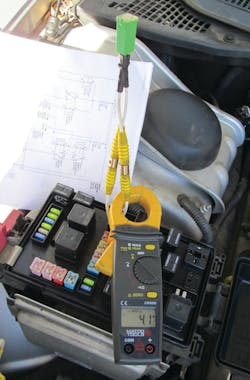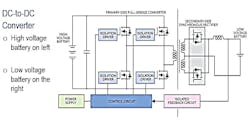Tool Briefing: Determine the cause of engine overheating
CUSTOMER CONCERN:
Engine overheating
VEHICLE APPLICATION:
2005 Dodge Magnum
STEPS:
- Pull trouble codes
- Verify fault or proper operation of system
- Command fan operation with the Scan Tool
- Have the right tools and tests in place to capture the fault if it shows up
- Use an infrared temperature gun to find the shorting fan
TOOLS USED:
- Scan tool
- Component test meter
- Electrical test adapters
- Current probes
- Test light
- Infrared heat gun
A 2005 Dodge Magnum with a 5.7L V8 came in with an overheating complaint. Normally, you’d want to verify the condition before testing, but who wants to overheat the customer’s engine on purpose? Luckily, the PCM had a stored P0480 code for an open cooling fan control circuit. (See Fig. 1.) It’s important to note here that a code like this could indicate an open or a short. The code is for an open, but a short would blow a fuse and create an open circuit anyway.
The wiring diagram showed that two fuses were used to control the dual fan system. The 40-amp fuse was blown, but the 50-amp fuse was fine. The diagram is a little hard to understand, but basically this Dodge uses a series/parallel fan design you’ll occasionally see on other vehicles as well.
At low speed, the 40-amp fuse feeds both fans in series, so they both drop 6 volts. Two relays are used to route the fans parallel to each other, with the 50-amp fuse feeding one fan and the 40-amp fuse feeding the other. From this information, it’s impossible to determine if there was a fault in a specific fan circuit.
There are plenty of great strategies for finding a short without blowing lots of test fuses. A test light can be connected across the fuse cavities.
With the key on, if the short is present, the test light would illuminate. An LED test light only flows about 40 miliamps (mA), so this is a great way to find shorts without flowing too much current through the system. However, this blown fuse controlled a brushed DC motor. These types of motors are a dead-short at rest, so the test light will always light up. By spinning them by hand, we are able to see if they feel like they’re mechanically binding. These felt fine. Therefore, a 40-amp fuse was risked, but it was installed using jumper leads to provide test access for current probes.
The scan tool was used to command fan operation key on, engine off (KOEO), which is a great way to test the fans without risking overheating. The Matco CM600 (Fig. 2) shows that the current through the fans is 4.1 amps on the current probe. The scan tool control doesn’t say it, but it controls only low speed fan operation, so this is the current through both fans in series. Clearly, there isn’t a problem with the fans or circuits during this test.
Since this isn’t a hard fault, there are three options: 1) Return the vehicle to the customer with a new fuse and risk their anger when they melt their engine. 2) Monitor the current while manipulating harnesses and shifting (to check motor mounts) to flush out a short in the harness. 3) Monitor the current while waiting for the motor to heat up, as many actuators only fail hot.
Since the first option isn’t good for customer loyalty, both of the other options were used. The first probe had a display for instantaneous readings, but for monitoring over time, the technician selected the PDI 60 amps probe connected to the component test meter. The screen was set to five minutes. While the fans were on and heating up, the harness was manipulated and the transmission was shifted repeatedly into all gears to stretch the harness.
The capture on the component test meter (Fig. 3) shows that the current slowly ramped up during the first minute, which is typical of brushed motors. Then one of the fans either shorted or seized up momentarily at about three and a half minutes, and then again at about four minutes. The current then went to zero amps because the 40-amp test fuse blew.
The minimum/maximum tracking on the component test meter shows that the peak current was 54.55 amps during the fault.
So it’s clear that there was a short, but it still hadn’t been decided if the problem was in the harness or in one of the fan motors.
To decide, the technician quickly grabbed a test light and connected the tip to one of the jumpers to the now-open fuse, and the ground clamp to the other jumper. This connection effectively powers the fans, but with only the 40 mA that flow through the test light. As stated before, brushed DC motors are a dead short at rest, so it’s to be expected that the test light will illuminate.
The fan connector was disconnected to see if the test light went out. The test light did go out, which indicated that there wasn’t a short in the harness. These fans are available separately, so it’s still important to determine which one shorted. But the individual fan connectors are very difficult to access, so a Raytek infrared thermometer was used to see which fan was the hottest (Fig. 4). After all, current must do work, and if it wasn’t spinning, the fan it must have been creating heat.
The left fan was only at 104 degrees F., but the right fan showed 234 degrees F. The right fan was ordered and replaced, and the vehicle was returned to the customer. In the end, this wasn’t a difficult diagnosis, but it’s a great example of a faster way to zero in on the root cause without wasting a lot of time (or 40-amp fuses).
Using a component test meter and an infrared heat gun helped pinpoint the actual shorting condition, and then the offending fan motor. If the short had been on the harness, the infrared gun may have been useful in finding the exact location of the short, though in today’s tightly packed engine compartments, that’s a hit-and-miss strategy.
On a side note, if the fans had run a significant amount of time without the fault showing up, the best strategy would have been to run them at high speed to stress them. Since the scan tool doesn’t have the ability to force high speed operation, you could remove the “fan high” and “fan high/low control” relays and jumper cavities 30 and 87. This will put the fans in parallel and use both the 40-amp and 50-amp current paths. An alternative strategy is to ground the front control module terminal 41, which should accomplish the same thing.


